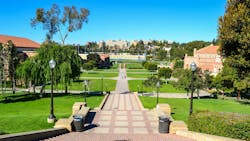New report finds potential for stormwater capture in LA County
The Pacific Institute, a U.S.-based global water think tank, released new research on August 15, 2024, showing the potential for stormwater capture on public school campuses in Los Angeles (LA) County, California.
The study utilizes 2NDNATURE’s Rainsteward tool to analyze the multi-benefits of greening schools. The report focused on LA County but is applicable to urban school campuses nationwide. It can offer a blueprint for creating greener and more resilient school environments.
The study, titled "Advancing Stormwater Capture for Greener Schools in Los Angeles,” estimates total stormwater runoff generated from LA County public school campuses is approximately 3.15 billion gallons per year. Of this amount, about 2.04 billion gallons per year could potentially be captured to augment water supplies and green school campuses.
The study highlights a local adaptation of the Pacific Institute’s national assessment launched earlier this year that estimates US urban areas have the potential to generate an average of 59.5 million acre-feet of stormwater runoff per year.
Urban schools across the U.S. are often blanketed in asphalt, creating urban heat islands with hot conditions. According to a Pacific Institute press release, during heavy rains, runoff from these impervious surfaces pollutes waterways and exacerbates flooding issues in surrounding neighborhoods.
Key finding from the report include:
- Of the 10 major watersheds in LA County, the Upper Los Angeles River Watershed tops the list with a stormwater capture potential on public school campuses of 557 million gallons per year, accounting for 27.4% of the total capture potential from public school campuses.
- Using the Rainsteward tool, the study demonstrates how the multi-benefits of water supply, water quality, flood reduction and urban heat mitigation can be used to prioritize school campuses for stormwater capture projects.
- Managing stormwater capture in LA County school campuses could prevent approximately 1,220 tons of pollutants from entering local waterways and the ocean each year.
- The project involved stakeholder engagement, incorporating insights from the Council for Watershed Health and the Los Angeles office of the Trust for Public Land. These organizations have valuable expertise and experience implementing and advocating for school greening projects in LA County.


